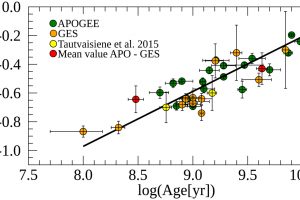Age and chemistry of the giant stars. The study: “The Gaia-ESO survey: Calibrating a relationship between age and the [C/N] abundance ratio with open clusters” of G. Casali (INAF – Osservatorio Astrofisico di Arcetri) recently appeared on A&A

Despite its importance for our comprehension of stellar and galactic evolution, stellar age is one of the most elusive stellar properties. In fact, we are able to determine stellar age with a good precision only in a few cases. Typical methods to determine this quantity are: the study of the chemical abundance of Lithium, stellar kinematics, stellar pulsations analyzed by asterosysmology, stellar rotation and magnetic activity. One of the most common used method is the comparison of stellar colors and magnitudes with those predicted by stellar evolutionary models which can synthesize these observable quantities. However, this method requires the knowledge of other quantities such as distance and extinction, and it is thus commonly used to date stars in stellar clusters, where they can easily determined.
It has also been demonstrated that the ratio of the abundances of some chemical elements in giant stars can trace their age. For instance, the ratio between Carbon and Nitrogen [C/N] seems to be particularly effective. These two chemical elements are produced in the CNO chain during the earlier stellar evolutionary phase. During the giant phase, the development of a convective zone alters the photospheric abundances of some chemical elements produced in the inner zones, such as Carbon and Nitrogen. Since the depth of the convective zone depends on stellar mass, which also depends on stellar age during the giant phase, the ratio [C/N] can trace stellar age efficiently.
Existing spectroscopic surveys at high spectral resolution which include stellar clusters with giant stars, such as the Gaia-ESO Survey and Apogee, offer a great opportunity to calibrate the relation between the [C/N] ratio and stellar age. This is the scope of the study “The Gaia-ESO survey: Calibrating a relationship between age and the [C/N] abundance ratio with open clusters” of G. Casali (University of Florence and INAF-Astrophysical Observatory of Arcetri), recently appeared on Astronomy and Astrophysics also thanks to the collaboration of the INAF-Osservatorio Astronomico di Palermo astronomers Francesco Damiani, Loredana Prisinzano e Rosaria Bonito. The authors have analyzed spectra at high resolution of giant stars in clusters whose age can be determined by the comparison with evolutive models, in order to measure their average [C/N] ratio and correlate it with stellar age. They have found a linear relation between [C/N] and the logarithm of stellar age. Using this relation, they have also studied the difference of the mean age of stars populating the two components of the disk of the Milky Way (the thin and thick disk) and the relation between stellar age and metallicity (which is the abundance of heavy elements over hydrogen)
The figure (link) shows the linear relation, determined in this study, between the logarithm of the age of the analyzed stellar clusters (divided based on the survey) and the [C/N] ratio of their giants stars.
by Mario Giuseppe Guarcello ( follow mguarce)
